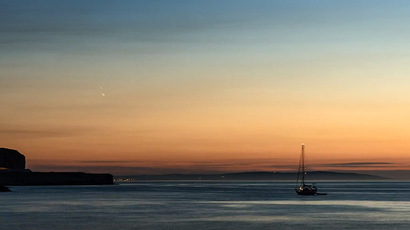Venus may have once been habitable, possessed atmosphere similar to Earth - NASA

Venus may have once had a shallow ocean and habitable temperatures, allowing it to support life for up to two billion years of its early history, according to NASA researchers.
Using a model similar to what is used to study climate change on Earth, scientists at NASA's Goddard Institute for Space Studies (GISS) concluded that the planet may have once been an entirely different place than modern-day Venus, which is a "hellish place" with a carbon dioxide atmosphere 90 times as thick as Earth's and almost no water vapor, and temperatures that reach 864 degrees Fahrenheit (462 degrees Celsius).
"Many of the same tools we use to model climate change on Earth can be adapted to study climates on other planets, both past and present," Michael Way, a researcher at GISS and the paper's lead author, said in a statement.
The research, published in the journal Geophysical Research Letters, was made possible by using previous data and applying it to a new hypothesis of what ancient Venus was really like.
First, the scientists used data from NASA's Pioneer mission in the 1980s, which suggested that Venus may have once had an ocean.
They then used newer research which, contrary to previous beliefs, found that just because a planet has a slow rotation rate - like Venus - doesn't mean it has a thick atmosphere. That is, although modern Venus has a thick atmosphere, an earlier Venus could have had a different - and more habitable - environment, while still maintaining the exact same rotation rate it does today.
Using that existing information, the scientists based their research on the assumption that ancient Venus had more dry land than Earth, particularly in the tropics. That would have limited the amount of water that was evaporated from the oceans. If that assumption was true, the hypothetical Venus of the past would have possessed an ideal environment to host life.
Moving forward, the researchers simulated a Venus with an atmosphere similar to Earth's, but with a day as long as Venus' current day, which totals 117 Earth days. They also threw in a shallow ocean which was consistent with data from Pioneer spacecraft.
They went on to add information about Venus' topography, using radar measurements taken by NASA's Magellan mission in the 1990s. They filled the lowlands with water, leaving the highlands exposed. They also included an ancient sun that was up to 30 percent dimmer. Even with those adjustments, they found that their ancient Venus model received about 40 percent more sunlight than modern-day Earth.
"In the GISS model's simulation, Venus' slow spin exposes its dayside to the sun for almost two months at a time," co-author and GISS scientist Anthony Del Genio said. "This warms the surface and produces rain that creates a thick layer of clouds, which acts like an umbrella to shield the surface from much of the solar heating. The result is mean climate temperatures that are actually a few degrees cooler than Earth's today."
The study was done as part of NASA's Planetary Scientce Astrobiology program through the Nexus for Exoplanet System Science (NexSS) program.














